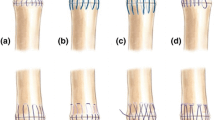Abstract
Purpose
This study was designed to compare the pull-out strength of simple suture stitches in human supraspinatus tendons with respect to the position of the rotator cable.
Methods
Fifty-four tests were performed on 6 intact, human supraspinatus tendons, to assess the cutout strength of a simple suture configuration in different positions; medial to, lateral to, or within the rotator cable. Tendon thickness was measured and correlated for each positioned suture.
Results
Suture positioning lateral to or in the rotator cable showed significantly lower suture retention properties compared with positioning the suture medial to the cable (p = 0.002). In all tested specimens, the central stitch in the row medial to the rotator cable provided the optimum retention properties (mean: 191 N; SD: ± 44; p < 0.01), even after correcting for tendon thickness.
Conclusion
This study shows that it is desirable to identify the rotator cable and to pass sutures just medial to it, close to the middle of the tendon, which provided highest possible suture retention properties.



Similar content being viewed by others
References
Baleani M, Ohman C, Guandalini L et al (2006) Comparative study of different tendon grasping techniques for arthroscopic repair of the rotator cuff. Clin Biomech 21(8):799–803
Baleani M, Schrader S, Veronesi CA, Rotini R, Giardino R, Toni A (2003) Surgical repair of the rotator cuff: a biomechanical evaluation of different tendon grasping and bone suture fixation techniques. Clin Biomech 18(8):721–729
Bishop J, Klepps S, Lo IK, Bird J, Gladstone JN, Flatow EL (2006) Cuff integrity after arthroscopic versus open rotator cuff repair: a prospective study. J Shoulder Elbow Surg 15(3):290–299
Boileau P, Brassart N, Watkinson DJ, Carles M, Hatzidakis AM, Krishnan SG (2005) Arthroscopic repair of full-thickness tears of the supraspinatus: does the tendon really heal? J Bone Joint Surg Am 87(6):1229–1240
Burkhart SS (1992) Fluoroscopic comparison of kinematic patterns in massive rotator cuff tears. A suspension bridge model. Clin Orthop Relat Res 284:144–152
Burkhart SS, Esch JC, Jolson RS (1993) The rotator crescent and rotator cable: an anatomic description of the shoulder’s “suspension bridge”. Arthroscopy 9(6):611–616
Clark JM, Harryman DT 2nd (1992) Tendons, ligaments, and capsule of the rotator cuff. Gross and microscopic anatomy. J Bone Joint Surg Am 74(5):713–725
Clark J, Sidles JA, Matsen FA (1990) The relationship of the glenohumeral joint capsule to the rotator cuff. Clin Orthop Relat Res 254:29–34
Coons DA, Barber FA, Herbert MA (2006) Triple-loaded single-anchor stitch configurations: an analysis of cyclically loaded suture-tendon interface security. Arthroscopy 22(11):1154–1158
Cummins CA, Murrell GA (2003) Mode of failure for rotator cuff repair with suture anchors identified at revision surgery. J Shoulder Elbow Surg 12(2):128–133
Demirhan M, Atalar AC, Kilicoglu O (2003) Primary fixation strength of rotator cuff repair techniques: a comparative study. Arthroscopy 19(6):572–576
Galatz LM, Ball CM, Teefey SA, Middleton WD, Yamaguchi K (2004) The outcome and repair integrity of completely arthroscopically repaired large and massive rotator cuff tears. J Bone Joint Surg Am 86(2):219–224
Gerber C, Schneeberger AG, Beck M, Schlegel U (1994) Mechanical strength of repairs of the rotator cuff. J Bone Joint Surg Br 76(3):371–380
Jost B, Pfirrmann CW, Gerber C (2000) Clinical outcome after structural failure of rotator cuff repairs. J Bone Joint Surg Am 82:304–314
Kask K, Kolts I, Lubienski A, Russlies M, Leibecke T, Busch LC (2008) Magnetic resonance imaging and correlative gross anatomy of the ligamentum semicirculare humeri (rotator cable). Clin Anat 21(5):420–426
Kim DH, Elattrache NS, Tibone JE et al (2006) Biomechanical comparison of a single-row versus double-row suture anchor technique for rotator cuff repair. Am J Sports Med 34(3):407–414
Koganti AK, Adamson GJ, Gregersen CS, Pink MM, Shankwiler JA (2006) Biomechanical comparison of traditional and locked suture configurations for arthroscopic repairs of the rotator cuff. Am J Sports Med 34(11):1832–1838
Lo IK, Burkhart SS (2003) The comma sign: an arthroscopic guide to the torn subscapularis tendon. Arthroscopy 19(3):334–337
Ma CB, Comerford L, Wilson J, Puttlitz CM (2006) Biomechanical evaluation of arthroscopic rotator cuff repairs: double-row compared with single-row fixation. J Bone Joint Surg Am 88(2):403–410
Ma CB, MacGillivray JD, Clabeaux J, Lee S, Otis JC (2004) Biomechanical evaluation of arthroscopic rotator cuff stitches. J Bone Joint Surg Am 86(6):1211–1216
Morag Y, Jacobson JA, Lucas D, Miller B, Brigido MK, Jamadar DA (2006) US appearance of the rotator cable with histologic correlation: preliminary results. Radiology 241(2):485–491
Roh MS, Wang VM, April EW, Pollock LU, Flatow EL (2000) Anterior and posterior musculotendinous anatomy of the supraspinatus. J Shoulder Elbow Surg 9(5):436–440
Sheah K, Bredella MA, Warner JJ, Halpern EF, Palmer WE (2009) Transverse thickening along the articular surface of the rotator cuff consistent with the rotator cable: identification with MR arthrography and relevance in rotator cuff evaluation. Am J Roentgenol 193(3):679–686
Tashjian RZ, Leventhal E, Spenciner DB, Green A, Flemmin BC (2007) Initial fixation strength of massive rotator cuff tears: in vitro comparison of single-row suture anchor and transosseous tunnel constructs. Arthroscopy 23(7):710–716
Volk AG, Vangsness CT Jr (2001) An anatomic study of the supraspinatus muscle and tendon. Clin Orthop Relat Res 384:280–285
Wang VM, Wang FC, McNickle AG et al (2010) Medial versus lateral supraspinatus tendon properties: implications for double-row rotator cuff repair. Am J Sports Med 38(12):2456–2463
White CD, Bunker TD, Hooper RM (2006) The strength of suture configurations in arthroscopic rotator cuff repair. Arthroscopy 22(8):837–841
Zumstein MA, Jost B, Hempel J, Hodler J, Gerber C (2008) The clinical and structural long-term results of open repair of massive tears of the rotator cuff. J Bone Joint Surg Am 90(11):2423–2431
Conflict of interest
The authors have no potential conflict of interest.
Author information
Authors and Affiliations
Corresponding author
Rights and permissions
About this article
Cite this article
Wieser, K., Rahm, S., Farshad, M. et al. Stitch positioning influences the suture hold in supraspinatus tendon repair. Knee Surg Sports Traumatol Arthrosc 21, 1587–1592 (2013). https://doi.org/10.1007/s00167-012-2103-6
Received:
Accepted:
Published:
Issue Date:
DOI: https://doi.org/10.1007/s00167-012-2103-6




